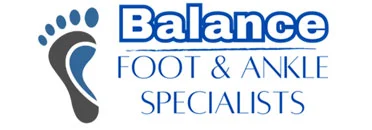Top of the Foot Pain:
Bone Growth On Top of Foot [Causes, Symptoms & Best Treatment]
A bone growth on top of the foot is an annoying but non-dangerous problem to have with your foot. Make 100% sure you are not missing anything!
Extra bone growth on top of foot treatment video:
Abnormal bone growth on top of foot causes:
Top of the Foot Pain Picture Gallery:
The most common causes of top of the foot pain:
- Top of the foot nerve compression.
- A swollen top of the foot can also occur due to stress across the top of the foot.
- Lisfranc fracture or sprain.
- Sprained top of the foot.
- Top of the foot bone spur.
- Hallux rigidus or dorsal 1st metatarsal joint spur.
- Dorsal foot compression syndrome.
- Flat foot compression leading to osteoarthritis.
Picture gallery of sharp pain on top of foot .
Bone growth on top of the foot overview:
- There are many different causes of bone growth on top of the foot.
- The most common is a metatarsal cuneiform exostosis, but this can cause nerve pressure on top of the foot.
- A bone growth on top of the foot is an annoying but non-dangerous problem to have. Luckily there are some treatments designed to handle it!
- This guide focuses specifically on the problems known as metatarsal cuneiform exostosis.
Causes:
- A very high foot arch (aka Cavus Foot).
- Increased mobility or hypermobility, essential to a “loose joint.”
- Irritation of the joint due to poor biomechanics.
- Genetics or family history
- Prior injury or broken foot
Specific Causes:
Top of the Foot Neuritis:
- A Medial Dorsal Cutaneous Nerve Neuritis can occur.
- This leads to a sensation of numbness, burning, or tingling.
- This can cause numbness, burning & tingling at the top of your foot & big toe.
- This is due to the compression of the nerve on top of your midfoot & big toe.
- This nerve compression is reversible, but it can take days, weeks, or months.
- This type of nerve irritation is known as neuropraxia.
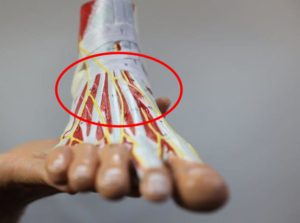
Muscle Knot On Top Of Foot:
It is also possible to have a muscle knot on top of the foot.
- This could be due to the extensor digitorium brevis.
- This is a ball of muscle on top of your foot.
- It is responsible for pulling your toes up.
- It is on the middle outside part of your foot, just before the ankle.

Knot on Top Of Foot Symptoms:
- Swelling or bruising on the suspected region.
- Difficulty pulling the toes up.
- Push on the muscle knot with your finger. If painful, this is likely.
- If it is bone, the knot on top of your foot will likely be on the inside top of the foot.
Metatarsal Exostosis: A hard bump
This is a fancy name for bone growth on top of your foot.
- The two bones at the joint can develop extra bone growth, which feels like a big lump on the top of your foot.
- It is usually associated with bone spurs or arthritis in your mid-foot.
- It is also common in high arched feet.
- This problem, unfortunately, is part of the bone, so it will either need surgery or accommodation.
- If it is really irritating you, this can cause medial dorsal cutaneous nerve irritation on top of your foot.
- This can cause numbness, burning, or tingling in the foot or the big toe.

Sprained Top Of Foot:
- A sprain in the top of the foot or the arch is called a Lisfranc sprain.
- In most cases, it is usually only a sprain that lasts a couple of days to a couple of weeks.
- But in some cases, it may be essential to seek imaging & further treatment.
Arch Pain & Mid-Foot Pain:
- Arch pain is one of the most common sources of foot pain in the world.
- 15% of all people get it in their lives.
- This pain is usually worse in the morning & gets better after moving around for a little while.
- If you have pain after rest & in the morning, consider this!

Ganglionic cyst – A soft bump:
- Ganglionic cysts are soft masses across the top of the foot which are not immediately dangerous!
- These are simply pockets of fluid that pouch out from the joints of your foot bones like a balloon.
- Treatment consists of draining and removing the pocket of fluid.
- But they should still check out by a podiatrist because there is a chance that they may be something a little more dangerous.

Symptoms:
- Tough bump on top of the foot.
- It rubs the skin against the top of your shoe.
- Difficulty finding shoes that fit properly
- Numbness, tingling, or burning may be associated with this problem.
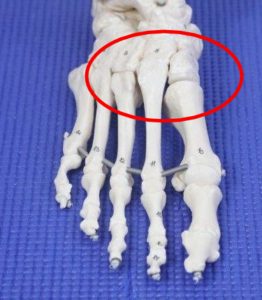
Home Treatment for Bony Growth
- The main goal of treating this disorder is to take the pressure of prominence.
- The second goal is to improve the improper biomechanics that is causing the pain in this area.
1)Reduce The Inflammation:
This should decrease the numbness, burning, and tingling in the foot if it exists. If you are not really in pain and experiencing numbness, burning, and tingling, skip to the more permanent treatments.
A)Ice:
- Like anti-inflammatory medications and elevating your foot, using ice is not just about reducing pain but also about reducing inflammation!
- Icing will decrease inflammation in that area and allow the tissues to start healing faster.
- Ice works by slowing down inflammatory cells, and then after the ice is removed, the blood flow increases and flushes away all the mediators and cells you don’t want in the painful area.
B)Cool Water Baths:
- If ice is just too impractical or unpleasant for you, try using some cool water, put it in a foot bath, and just soak your feet in it for 10-20 minutes using the same principles as above.
- Wait for your feet to adjust to the cool water, and then finish your bath.
C)Elevation:
- Like the Icing and the anti-inflammatory medication, this will help decrease the anti-inflammatory cells in the region.
- Just toss up your feet throughout the day on some pillows while watching TV and combine it with ice for best results!
D)Anti-inflammatory Medication:
- The goal of this treatment is not for pain relief!
- Most guys especially say they don’t need it for the pain or that it doesn’t even help that much, but this is to help your tissues heal faster, not so much for the pain relief.
- Anti-inflammatory medications like Advil, Ibuprofen, Motrin, or Aspirin help speed up the healing process by stopping inflammatory cells in your body from further destroying tissues. The immune system is stuck in a problematic cycle where it is trying to remodel the tissues, but as the weeks and months go by, they just never get there.
- This is where anti-inflammatory medications come in.
E)Combined Ice/Cooling, Elevation, and Anti-inflammatory medication:
- These three combined together have shown great results in research studies.
Inflammation Products:
Relieve Pain & Inflammation So That You Can Stretch:
- Relief of stress from the site is significant.
- You can’t stretch or heal a 10/10 painful and sore muscle.
- You have to cool it down first.
- We prefer icing for 20 minutes at a time, but if you want to save time => Try Biofreeze!
- As the muscles relax, the midfoot and top of the foot can work more naturally and flexibly.
Relax the Muscle So That It is More Flexible:
- Massage roller sticks and devices will help you get more flexible.
- After you massage the muscle, it is important to take advantage and get more flexible.
- This works best through the calf muscle, the hamstring, and the thigh muscle.
- This also works well for the gluteal muscles and hips.
2)Offload the Bump:
- Padding – Any felt pad or gel pad will work. The goal is to prevent the foot from rubbing against the top of your shoe.
- Skip Lacing – Lace up your shoes so that you skip the area where the bump on top of your foot is.
- Limit your barefoot walking or walking without orthotics- walking barefoot flattens out your foot and compresses that joint.
- Orthotics- get your hands on a good but still not expensive pair of orthotics such as powersteps ($25 or so)
- Shoes: Properly measure yourself for your shoe using a Brannock Device at an athletic shoe store. Getting some extra depth shoes and skip lacing should be enough to avoid putting pressure on the bump.
For Bone Growth on the Top of the Front of the Foot:
Biomechanical Correction:
Get Great Shoes:
- The key to preventing your heel pain is to have a good supportive shoe that supports your ankle joint and subtalar joint from everting.
- If you have a good supportive shoe that keeps pressure on your joints so that your ankle, Achilles tendon, and subtalar joint do not have to work as hard.
- This almost seems counter-intuitive, but when people switch to really good supportive shoes that fit properly, the ankle and Achilles tendon pain should gradually improve.
- A great orthotic and a great shoe work very well for the top of the foot pain and arthritis.
Get A Great Stability Brace:
- When you are very sore… Make sure you have great support.
- As the soreness decreases, you can go with a long-term compression brace.
- As the ankle stability is maintained, less compensation through the midfoot and top of the foot occur.






Get A Great Compression Brace:
- These are more for long-term support.
- The stability braces are better for heavy-duty and severe injury.
- As the ankle stability is maintained, less compensation through the midfoot and top of the foot occur.




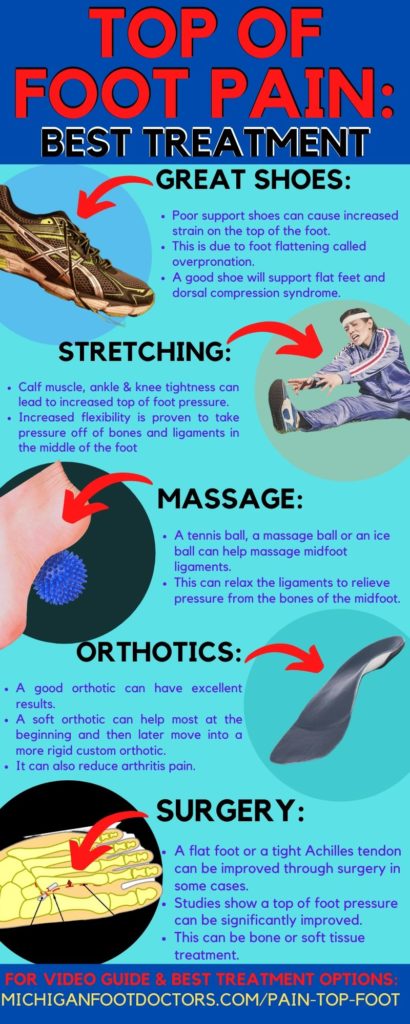
Top of the Foot Home Treatment:
- There are usually two phases to treating the gout on top of the foot pain treatment.
- This doesn’t matter whether it’s an intermittent sharp pain on top of the foot, pain on top of the foot near toes, tendonitis on top of the foot, or a top of the foot bone spur. Treatment is all roughly very similar.
- The two phases of treatment include controlling the acute inflammation and correcting the biomechanics, which led to the problem in the first place.
- Great top-of-the-foot shoes and great orthotics lead to the prevention of dorsal compression syndrome. This prevents compression on top of the foot. It prevents the stretching on the bottom of the foot.
- This will also reduce your numbness, burning, and tingling pain.
Control Inflammation:
Massage & Ice Products:
- The metal ball is one of my personal favorites.
- This can work well for a bruised top of the foot.
- This is not a permanent solution. You still need to remove the stress off of the top of the foot.






Menthol Based Gels:
- Biofreeze is one of our favorites.
- These gels have been studied to work 2x as long as ice.
- This can also work as a great option for a bruised top of the foot or top of the foot extensor tendonitis.
- This is not a permanent solution. You still need to remove the stress off of the top of the foot.








Massage Sticks:
- These can work great for loosening your muscles.
- This allows less tightness and pressure on the ball of your foot.
- This works best for extensor tendonitis on the top of the foot.






Removing The Stress:
- The key is to prevent future pain.
- If you can get rid of the pain and swelling, this will let you start walking normally.
- If you can walk normally, the vast majority of your pain should gradually start to go away.
- This will limit dorsal compression syndrome and limit extensor tendonitis to the top of the foot.
Best Top of the Foot Pain Shoes:
- Getting a great supportive pair of shoes will ensure that pressure is removed from the top of the foot.
- There is much less compression appreciated.
- This is especially important if you have a swollen top of your foot, intermittent sharp pain on top of your foot, and top of the foot compression.
- Consider shoes combined with a good supportive orthotic for the best pain relief!
- The following link will show you what our favorites are.
The Best Top of the Foot Pain Orthotics:
- These are our recommended orthotics.
- There are different types of different shoes.
- Women’s shoes usually need a less bulky orthotic but allow for less correction.
- A full-length orthotic requires a running shoe, boot, or comfortable walking/dress shoe.
Best Full-Length Orthotics:








Best Dress Shoe Orthotics:






Best 3/4 Length Orthotics:


Get A Great Dynamic Stretch:
- It is possible to stretch on your own, but these products can also really help!
- This will take pressure off of the ball of your foot.








Get A Great Static Stretch:
- These devices are great for stretching while you are resting.
- This will also help take pressure off of the ball of your foot.






Top of the Foot Pain Trauma:
- If you have a sprain Of the foot, Lisfranc fracture, or a fracture to the top of the foot, you need to protect it.

- The recommended way of doing this is to offload with a good supportive boot or cast.
- The best way to do this is, of course, to see your podiatrist and get evaluated with an x-ray, ultrasound, and potentially even an MRI or CT scan.
- If you cannot do so, it may benefit you to be in a cast, fractured boot, or even keep the weight off of it with a rolling knee scooter or other protective devices.
- We as podiatrists frequently take patients off work for a very long period of time when they suffer a traumatic injury. Unfortunately, there is no other way around us in labor jobs.
- If you have a sit-down job, there are ways to get people back to work quicker, but this can be impossible otherwise.
Top of the Foot Fracture Boot Treatment:
- There are pros and cons to using a boot to treat your foot pain. The pros are that your injured heel will hopefully have a chance to heal gradually! If you are immobilized too long, the cons are that you will gradually become stiff and overworked to your other leg. r
- Our favorite fracture boots and their supplies:








Offloading and Scooter treatment:
- These are favorite knee scooters and walking devices.
- If your Achilles tendonitis pain is severe, offloading can be very effective until the pain calms down.








